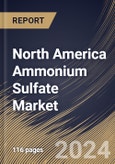Farmers and agribusinesses are adopting fertilizers with lower environmental impact, and it is gaining traction due to its eco-friendly characteristics. Its use as a byproduct of various industrial processes aligns with the growing demand for sustainable and circular agricultural practices. This trend influences the adoption of this in agriculture, especially in regions where sustainable farming practices are a priority. Stakeholders are exploring and promoting fertilization methods that balance productivity with environmental considerations.
Precision agriculture involves using technology to optimize field-level management of crop farming. The adoption of precision agriculture practices, including variable rate fertilization, influences the application of fertilizers such as ammonium sulfate. This trend allows for targeted and efficient use of fertilizers based on specific crop and soil conditions. Precision agriculture contributes to a more efficient use of it, minimizing overuse and reducing environmental impact. The trend aligns with the broader goal of sustainable agriculture and resource optimization. Ongoing advancements in manufacturing processes are influencing the production of this. Innovations focus on improving efficiency, reducing production costs, and improving the overall quality of the product. Technologies that address environmental concerns and contribute to sustainable production are gaining attention.
As the population grows, there is a corresponding increase in food demand in Mexico. This can drive the need for improved agricultural practices and fertilizers, including it, to enhance crop productivity in Mexico. Adopting modern and efficient farming techniques, such as precision agriculture, may increase demand for specialized fertilizers like this in Mexico. The specific climatic and soil conditions in Mexico may favor certain fertilizers. Ammonium sulfate is considered environmentally friendly compared to other nitrogen fertilizers in Mexico. If there is an increased emphasis on sustainable and environmentally conscious agricultural practices in Mexico, it may drive the demand for such fertilizers. Hence, the factors mentioned above will drive the regional market growth.
The US market dominated the North America Ammonium Sulfate Market, By Country in 2022, and would continue to be a dominant market till 2030; thereby, achieving a market value of $658 million by 2030. The Mexico market is registering a CAGR of 6.3% during (2023 - 2030). Additionally, The Canada market would showcase a CAGR of 6.2% during (2023 - 2030).
Based on Product, the market is segmented into Solid, and Liquid. Based on Application, the market is segmented into Fertilizers, Food & Feed Additives, Pharmaceuticals, Water Treatment, and Others. Based on countries, the market is segmented into U.S., Mexico, Canada, and Rest of North America.
List of Key Companies Profiled
- BASF SE
- Evonik Industries AG (RAG-Stiftung)
- LANXESS AG
- SABIC (Saudi Arabian Oil Company)
- Sumitomo Chemical Co. Ltd.
- Honeywell International, Inc.
- Helm AG
- ArcelorMittal S.A.
- Akzo Nobel N.V.
- Domo Chemicals GmbH
Market Report Segmentation
By Product (Volume, Kilo Tonnes, USD Billion, 2019-2030)- Solid
- Liquid
- Fertilizers
- Food & Feed Additives
- Pharmaceuticals
- Water Treatment
- Others
- US
- Canada
- Mexico
- Rest of North America
Table of Contents
Companies Mentioned
- BASF SE
- Evonik Industries AG (RAG-Stiftung)
- LANXESS AG
- SABIC (Saudi Arabian Oil Company)
- Sumitomo Chemical Co. Ltd.
- Honeywell International, Inc.
- Helm AG
- ArcelorMittal S.A.
- Akzo Nobel N.V.
- Domo Chemicals GmbH








